The Effect of Strategic Marketing Planning Behaviour
- 格式:pdf
- 大小:1.10 MB
- 文档页数:13
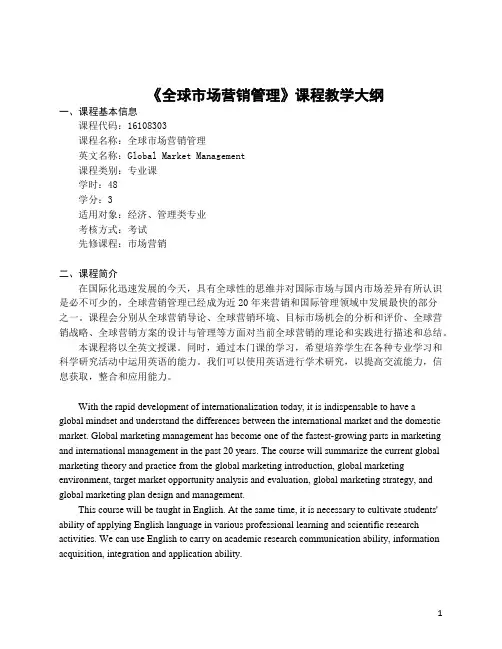
《全球市场营销管理》课程教学大纲一、课程基本信息课程代码:16108303课程名称:全球市场营销管理英文名称:Global Market Management课程类别:专业课学时:48学分:3适用对象:经济、管理类专业考核方式:考试先修课程:市场营销二、课程简介在国际化迅速发展的今天,具有全球性的思维并对国际市场与国内市场差异有所认识是必不可少的,全球营销管理已经成为近20年来营销和国际管理领域中发展最快的部分之一。
课程会分别从全球营销导论、全球营销环境、目标市场机会的分析和评价、全球营销战略、全球营销方案的设计与管理等方面对当前全球营销的理论和实践进行描述和总结。
本课程将以全英文授课。
同时,通过本门课的学习,希望培养学生在各种专业学习和科学研究活动中运用英语的能力。
我们可以使用英语进行学术研究,以提高交流能力,信息获取,整合和应用能力。
With the rapid development of internationalization today, it is indispensable to have aglobal mindset and understand the differences between the international market and the domestic market. Global marketing management has become one of the fastest-growing parts in marketing and international management in the past 20 years. The course will summarize the current global marketing theory and practice from the global marketing introduction, global marketing environment, target market opportunity analysis and evaluation, global marketing strategy, and global marketing plan design and management.This course will be taught in English. At the same time, it is necessary to cultivate students' ability of applying English language in various professional learning and scientific research activities. We can use English to carry on academic research communication ability, information acquisition, integration and application ability.三、课程性质与教学目的本课程是一门全英课程,是专门针对金融学(“2+2”实验班)本科学生开设的一门专业必修课。
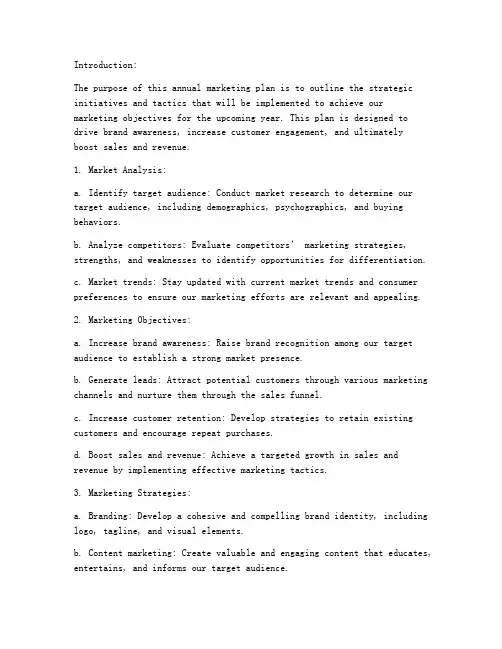
Introduction:The purpose of this annual marketing plan is to outline the strategic initiatives and tactics that will be implemented to achieve ourmarketing objectives for the upcoming year. This plan is designed to drive brand awareness, increase customer engagement, and ultimatelyboost sales and revenue.1. Market Analysis:a. Identify target audience: Conduct market research to determine our target audience, including demographics, psychographics, and buying behaviors.b. Analyze competitors: Ev aluate competitors’ marketing strategies, strengths, and weaknesses to identify opportunities for differentiation.c. Market trends: Stay updated with current market trends and consumer preferences to ensure our marketing efforts are relevant and appealing.2. Marketing Objectives:a. Increase brand awareness: Raise brand recognition among our target audience to establish a strong market presence.b. Generate leads: Attract potential customers through various marketing channels and nurture them through the sales funnel.c. Increase customer retention: Develop strategies to retain existing customers and encourage repeat purchases.d. Boost sales and revenue: Achieve a targeted growth in sales and revenue by implementing effective marketing tactics.3. Marketing Strategies:a. Branding: Develop a cohesive and compelling brand identity, including logo, tagline, and visual elements.b. Content marketing: Create valuable and engaging content that educates, entertains, and informs our target audience.c. Social media marketing: Leverage social media platforms to increase brand visibility, engage with customers, and drive traffic to our website.d. Email marketing: Build and maintain a strong email list, and send targeted and personalized email campaigns to nurture leads and retain customers.e. Influencer marketing: Collaborate with influencers in our industry to reach a wider audience and enhance brand credibility.f. Public relations: Establish relationships with media outlets to secure coverage and promote our brand and products.4. Marketing Tactics:a. Launch a new product: Introduce a new product or service that meets the evolving needs of our target audience.b. Run promotional campaigns: Organize special offers, discounts, and contests to incentivize purchases and increase brand loyalty.c. Host events: Organize live events, webinars, and workshops to engage with customers and build relationships.d. Search engine optimization (SEO): Optimize our website and contentfor search engines to improve organic traffic and visibility.e. Pay-per-click (PPC) advertising: Invest in PPC campaigns to drive targeted traffic to our website and generate leads.f. Referral program: Implement a referral program to encourage existing customers to refer new customers, thereby expanding our customer base.5. Marketing Budget:Allocate a budget for each marketing channel and tactic, ensuring that resources are allocated effectively to achieve our marketing objectives. Monitor the performance of each channel and adjust the budget accordingly.6. Measurement and Reporting:a. Define key performance indicators (KPIs): Establish clear KPIs to measure the success of our marketing efforts, such as website traffic, conversion rates, and sales growth.b. Track and analyze data: Regularly track and analyze data to assessthe performance of our marketing strategies and tactics.c. Report and optimize: Provide regular reports to stakeholders, highlighting the progress and effectiveness of our marketing initiatives. Continuously optimize our strategies based on data-driven insights.Conclusion:This annual marketing plan outlines the strategic initiatives andtactics that will be implemented to achieve our marketing objectives for the upcoming year. By executing this plan effectively, we aim toincrease brand awareness, generate leads, boost sales, and ultimately drive business growth. Regular monitoring, analysis, and optimizationwill ensure the continuous improvement of our marketing efforts.。
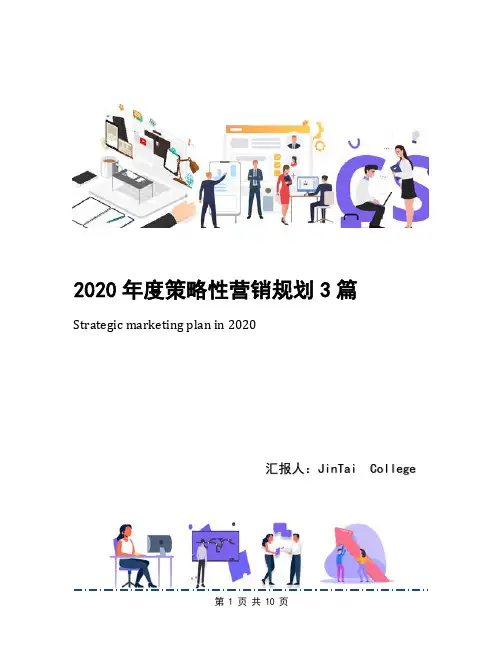
2020年度策略性营销规划3篇Strategic marketing plan in 2020汇报人:JinTai College2020年度策略性营销规划3篇前言:工作计划是对一定时期的工作预先作出安排和打算时制定工作计划,有了工作计划,工作就有了明确的目标和具体的步骤,大家协调行动,使工作有条不紊地进行。
工作计划对工作既有指导作用,又有推动作用,是提高工作效率的重要手段。
本文档根据工作计划的书写内容要求,带有规划性、设想性、计划性、方案和安排的特点展开说明,具有实践指导意义。
便于学习和使用,本文档下载后内容可按需编辑修改及打印。
本文简要目录如下:【下载该文档后使用Word打开,按住键盘Ctrl键且鼠标单击目录内容即可跳转到对应篇章】1、篇章1:2020年度策略性营销规划2、篇章2:2020年度策略性营销规划3、篇章3:2020年度策略性营销规划篇章1:2020年度策略性营销规划一、稳定与老客户的关系对于老客户,和固定客户,要经常保持联系,在有时间有条件的情况下,送一些小礼物或宴请客户,好稳定与客户关系。
二、获得更多的新客户在拥有老客户的同时还要不断从各种媒体获得更多客户信息。
三、加强学习要有好业绩就得加强业务学习,开拓视野,丰富知识,采取多样化形式,把学业务与交流技能向结合。
四、今年对自己有以下要求1、每月要增加1个以上的新客户,还要有到个潜在客户。
2、一周一小结,每月一大结,看看有哪些工作上的失误,及时改正下次不要再犯。
3、见客户之前要多了解客户的状态和需求,再做好准备工作才有可能不会丢失这个客户。
4、对客户不能有隐瞒和欺骗,这样不会有忠诚的客户。
在有些问题上你和客户是一直的。
5、要不断加强业务方面的学习,多看书,上网查阅相关资料,与同行们交流,向他们学习更好的方式方法。
6、对所有客户的工作态度都要一样,但不能太低三下气。
给客户一好印象,为公司树立更好的形象。
7、客户遇到问题,不能置之不理一定要尽全力帮助他们解决。
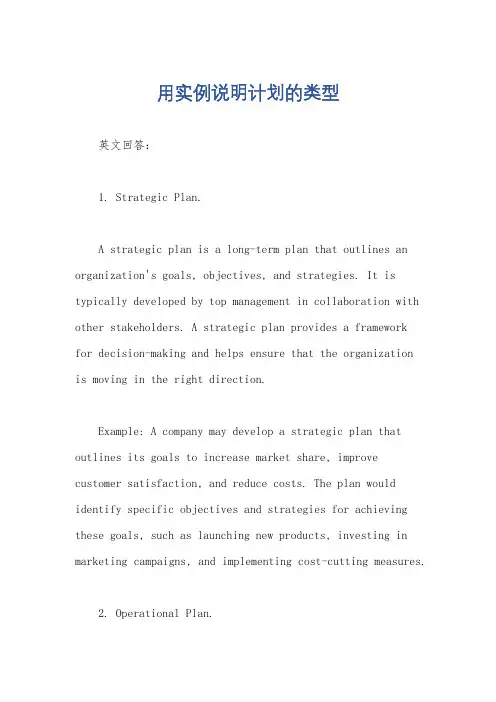
用实例说明计划的类型英文回答:1. Strategic Plan.A strategic plan is a long-term plan that outlines an organization's goals, objectives, and strategies. It is typically developed by top management in collaboration with other stakeholders. A strategic plan provides a frameworkfor decision-making and helps ensure that the organizationis moving in the right direction.Example: A company may develop a strategic plan that outlines its goals to increase market share, improve customer satisfaction, and reduce costs. The plan would identify specific objectives and strategies for achieving these goals, such as launching new products, investing in marketing campaigns, and implementing cost-cutting measures.2. Operational Plan.An operational plan is a short-term plan that outlines the specific steps that need to be taken to achieve the goals and objectives outlined in the strategic plan. It is typically developed by middle management and focuses onday-to-day operations. An operational plan provides a roadmap for execution and helps ensure that the organization is on track to meet its goals.Example: A company may develop an operational plan to implement a new marketing campaign. The plan would outline the specific tasks that need to be completed, such as creating marketing materials, developing a budget, and targeting specific customer segments.3. Project Plan.A project plan is a detailed plan that outlines the steps that need to be taken to complete a specific project. It typically includes a project timeline, budget, and resource allocation. A project plan helps ensure that the project is completed on time, within budget, and to therequired quality standards.Example: A company may develop a project plan to launch a new product. The plan would outline the specific tasks that need to be completed, such as product development, market research, and manufacturing.4. Business Plan.A business plan is a comprehensive document that outlines a company's business model, strategies, and financial projections. It is typically used to attract investors or lenders. A business plan provides a roadmapfor the company's future and helps ensure that it is on the right track to success.Example: A company may develop a business plan to attract investors for a new product launch. The plan would outline the company's target market, marketing strategies, and financial projections.5. Marketing Plan.A marketing plan is a detailed plan that outlines a company's marketing strategies, tactics, and budget. It is typically developed by marketing managers and focuses on reaching target customers with the right message, at the right time, and through the right channels. A marketing plan helps ensure that the company's marketing efforts are effective and efficient.Example: A company may develop a marketing plan to launch a new product. The plan would outline the target market, marketing objectives, marketing strategies, and budget.中文回答:1. 战略计划。
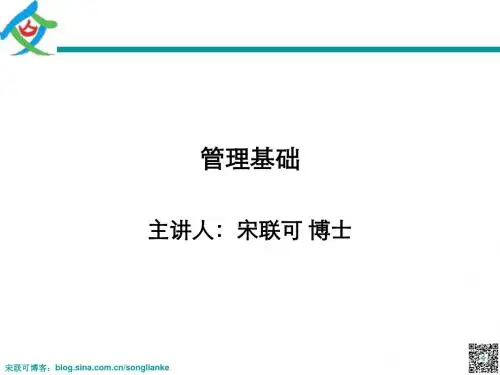
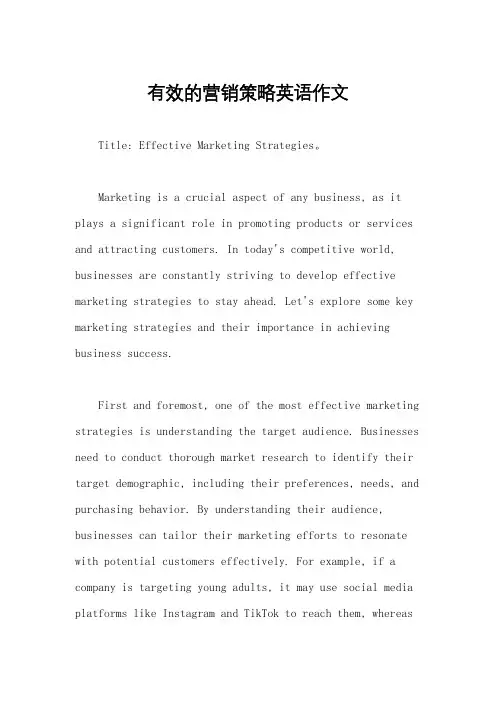
有效的营销策略英语作文Title: Effective Marketing Strategies。
Marketing is a crucial aspect of any business, as it plays a significant role in promoting products or services and attracting customers. In today's competitive world, businesses are constantly striving to develop effective marketing strategies to stay ahead. Let's explore some key marketing strategies and their importance in achieving business success.First and foremost, one of the most effective marketing strategies is understanding the target audience. Businesses need to conduct thorough market research to identify their target demographic, including their preferences, needs, and purchasing behavior. By understanding their audience, businesses can tailor their marketing efforts to resonate with potential customers effectively. For example, if a company is targeting young adults, it may use social media platforms like Instagram and TikTok to reach them, whereasif the target audience is older individuals, traditional marketing channels like newspapers and television might be more effective.Another essential marketing strategy is building a strong brand identity. A brand is not just a logo or a product; it's the perception that consumers have of a company. Establishing a strong brand identity helps businesses differentiate themselves from competitors and build trust with customers. Consistency in branding across all marketing channels is crucial for brand recognition.For instance, Apple has built a strong brand identity through its minimalist design, innovative products, and memorable marketing campaigns, making it one of the most valuable brands globally.Furthermore, effective storytelling is a powerful marketing tool. People connect with stories, and businesses can leverage this by telling compelling narratives that evoke emotions and resonate with their audience. By telling stories that showcase the values and mission of the company, businesses can create a deeper connection with customers.For example, TOMS Shoes has successfully used storytelling to promote its "One for One" campaign, where for every pair of shoes purchased, the company donates a pair to a childin need. This story of giving back not only promotes the product but also appeals to customers' desire to make a positive impact.In addition to storytelling, content marketing is another vital strategy in today's digital age. Content marketing involves creating and sharing valuable, relevant content to attract and engage a target audience. This content can take various forms, including blog posts, videos, infographics, and podcasts. By providing valuable information or entertainment, businesses can establish themselves as industry experts and build credibility with their audience. For example, HubSpot, a marketing software company, offers a wealth of free resources, including blog posts, e-books, and webinars, to educate and attract potential customers.Moreover, leveraging social media platforms isessential for modern marketing strategies. With billions ofusers worldwide, platforms like Facebook, Instagram, Twitter, and LinkedIn offer businesses unparalleled opportunities to reach their target audience. By engaging with customers through regular posts, responding to comments and messages, and running targeted advertising campaigns, businesses can increase brand awareness and drive traffic to their websites. For example, Wendy's, a fast-food chain, is known for its witty and engaging posts on Twitter, which have helped the brand gain a significant following and increase engagement with its audience.Additionally, influencer marketing has become increasingly popular in recent years. Influencers are individuals who have a large following and can influence the purchasing decisions of their audience. By partnering with influencers relevant to their industry, businesses can reach a wider audience and build credibility. For example, beauty brands often collaborate with makeup artists and beauty bloggers to promote their products, leveraging the influencers' expertise and large following to drive sales.Furthermore, personalized marketing is essential forconnecting with customers on a more individual level. With advancements in technology, businesses can collect data on their customers' preferences, purchase history, and behavior to deliver personalized marketing messages. Personalization can take many forms, such as personalized email campaigns, product recommendations based on past purchases, and targeted advertising. For example, Amazon uses personalized recommendations based on a customer's browsing and purchase history to suggest products they might be interested in, enhancing the shopping experience and increasing sales.In conclusion, effective marketing strategies are essential for businesses to thrive in today's competitive market. By understanding their target audience, building a strong brand identity, storytelling, content marketing, leveraging social media, influencer marketing, and personalized marketing, businesses can attract and retain customers, increase brand awareness, and drive sales. However, it's crucial for businesses to continually evaluate and adapt their marketing strategies to stay relevant and meet the evolving needs of their audience.With the right marketing strategies in place, businesses can achieve sustainable growth and success.。
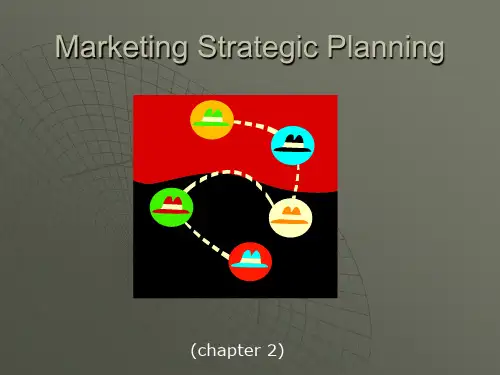
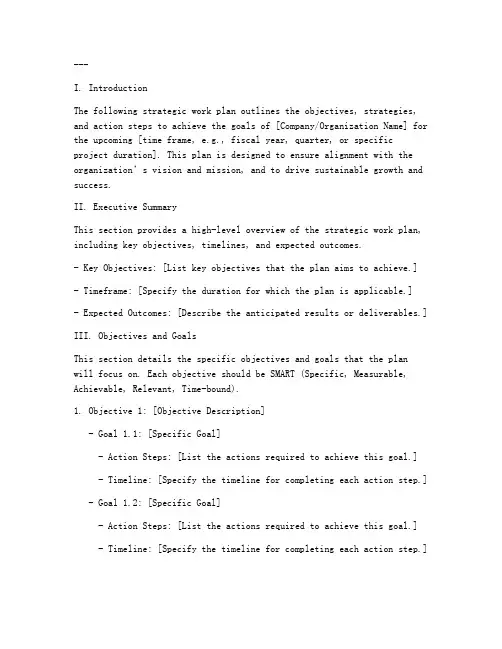
---I. IntroductionThe following strategic work plan outlines the objectives, strategies, and action steps to achieve the goals of [Company/Organization Name] for the upcoming [time frame, e.g., fiscal year, quarter, or specificproject duration]. This plan is designed to ensure alignment with the organization’s vision and mission, and to drive sustainable growth and success.II. Executive SummaryThis section provides a high-level overview of the strategic work plan, including key objectives, timelines, and expected outcomes.- Key Objectives: [List key objectives that the plan aims to achieve.]- Timeframe: [Specify the duration for which the plan is applicable.]- Expected Outcomes: [Describe the anticipated results or deliverables.]III. Objectives and GoalsThis section details the specific objectives and goals that the planwill focus on. Each objective should be SMART (Specific, Measurable, Achievable, Relevant, Time-bound).1. Objective 1: [Objective Description]- Goal 1.1: [Specific Goal]- Action Steps: [List the actions required to achieve this goal.]- Timeline: [Specify the timeline for completing each action step.]- Goal 1.2: [Specific Goal]- Action Steps: [List the actions required to achieve this goal.]- Timeline: [Specify the timeline for completing each action step.]- Expected Outcomes: [Describe the expected outcomes of achieving this goal.]2. Objective 2: [Objective Description]- Goal 2.1: [Specific Goal]- Action Steps: [List the actions required to achieve this goal.]- Timeline: [Specify the timeline for completing each action step.]- Goal 2.2: [Specific Goal]- Action Steps: [List the actions required to achieve this goal.]- Timeline: [Specify the timeline for completing each action step.]- Expected Outcomes: [Describe the expected outcomes of achieving this goal.]IV. Strategies and InitiativesThis section outlines the strategies and initiatives that will be employed to achieve the objectives and goals.1. Strategy 1: [Strategy Description]- Initiative 1.1: [Specific Initiative]- Responsibility: [Assign responsibility to an individual or team.]- Timeline: [Specify the timeline for completing the initiative.]- Initiative 1.2: [Specific Initiative]- Responsibility: [Assign responsibility to an individual or team.]- Timeline: [Specify the timeline for completing the initiative.]2. Strategy 2: [Strategy Description]- Initiative 2.1: [Specific Initiative]- Responsibility: [Assign responsibility to an individual or team.]- Timeline: [Specify the timeline for completing the initiative.]- Initiative 2.2: [Specific Initiative]- Responsibility: [Assign responsibility to an individual or team.]- Timeline: [Specify the timeline for completing the initiative.]V. Resources and BudgetThis section details the resources required to implement the strategic work plan, including personnel, equipment, and financial resources.- Personnel: [List the roles and responsibilities required to execute the plan.]- Equipment: [Identify any specialized equipment or tools needed.]- Budget: [Provide a detailed budget breakdown for the plan.]VI. Risk ManagementThis section identifies potential risks and outlines mitigation strategies to minimize their impact on the strategic work plan.- Risk 1: [Risk Description]- Mitigation Strategy: [Describe the actions to be taken to mitigate this risk.]- Risk 2: [Risk Description]- Mitigation Strategy: [Describe the actions to be taken to mitigate this risk.]VII. Monitoring and EvaluationThis section outlines the mechanisms for monitoring progress and evaluating the effectiveness of the strategic work plan.- Key Performance Indicators (KPIs): [List the KPIs that will be used to measure success.]- Reporting Schedule: [Specify the frequency and format of progress reports.]- Review Meetings: [Schedule regular review meetings to discuss progress and adjust the plan as needed.]VIII. ConclusionThe strategic work plan serves as a roadmap for [Company/Organization Name] to achieve its objectives and drive sustainable success. By following the outlined strategies and initiatives, the organization is poised to overcome challenges and capitalize on opportunities. This plan will be revisited and updated as needed to ensure its relevance and effectiveness.---Note: This template is a guideline and should be customized to fit the specific needs and context of the。
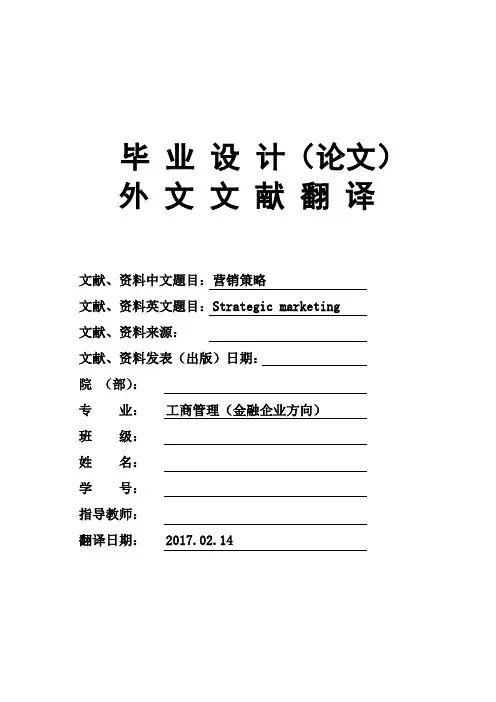
毕业设计(论文)外文文献翻译文献、资料中文题目:营销策略文献、资料英文题目:Strategic marketing文献、资料来源:文献、资料发表(出版)日期:院(部):专业:工商管理(金融企业方向)班级:姓名:学号:指导教师:翻译日期: 2017.02.14外文翻译专业:工商管理(金融企业管理方向)外文原文:Strategic marketing①No matter how good the organization's products or services, unless their value can be communicated to potential customers, the organization will fail in its mission. This co mmunication is the responsibility of the marketing function within the organization. A ccording to the American Marketing Association, marketing is "an organizational func tion and a set of processes for creating, communicating and delivering value to custo mers and for managing customer relationships in ways that benefit the organization an d its stakeholders." Strategic marketing examines the marketplace to determine the ne eds of potential customers and the nature of the competitors in the market, and attemp ts to develop a strategy that will enable the organization to gain or maintain acompetit ive advantage in the marketplace. Operational marketing is built upon the foundation set by the strategic marketing function and implements various plans and strategies (in cluding a development of the appropriate marketing mix) to attract customers and fost er customer loyalty.Methods for Product & Service MarketingThere a number of ways to market one's products or services including advertising, di rect response, sales promotions, and publicity. However, unless one understands the n eeds of the customer, the market, and the industry as well as the strengths and weakne sses of the competition, these approaches are unlikely to be successful. Strategic mark eting helps an organization sharpen its focus and successfully compete in the marketpl ace. Strategic marketing is concerned with two components: The target market and the①Marketing strategy (Research: A. Ruth marketing organization and marketing, America press 2008: 1-1)best way to communicate the value of one's product or service to that market. The de velopment of a viable marketing strategy depends on several key dimensions. First, as with any global strategy within the organization, a successful marketing strategy need s to be endorsed by top management within the organization. Marketing strategy is als o political in nature: Powerful units within the organization may disagree on the best marketing strategy and an accord may need to be negotiated. Marketing strategies ma y also be affected by organizational culture and the assumptions that this engenders. F or example, if the organization has always marketed its widgets to business executives , it may fail to see the potential for marketing to lower level personnel within the orga nization or even for personal use to adults or teenagers.Factors that Implement Strategic Marketing Plan DevelopmentThere are a number of factors that should impact the development of a strategic mark eting plan for the organization. The first of these comprises the assets and skills that th e organization already possesses or that it can readily acquire. For example, if an orga nization has a significant programming department on the payroll, it would be feasible for it to make and market application software. However, if these personnel are alrea dy involved in other work and are not free to work on a new software project and the organization cannot afford to hire additional programmers, starting a new software lin e would be inadvisable at best. The second factor that must be considered when devel opinga marketing strategy is the market drivers. These are various political, economic, sociocultural, and technological forces that can influence the wants and needs of the c onsumer base. For example, the need to be able to handle increasing volumes of infor mation and data has led to widespread use of information technology in many industri es. Similarly, the need for a college education for an increasing number of jobs has led to a proliferation of for-profit institutions of higher education. Factors Impacting Marketing StrategyMarket drivers, however, are not the only external force that shapes one's market strat egy. The nature of the competition in the marketplace is also very important in determ ining whether or not a marketing effort will be successful. Virtually no business is wit hout competition. When buying a computer, one must choose between Mac and PC.Most soft drinks on the market are manufactured by one of two companies who offer very similar products. There is a variety of choices available when deciding where to f ill up one's car, yet most of the fuels available at the pump are virtually the same. Eac h of these businesses has its own market position and strives to keep its market share t hrough marketing efforts. Part of the strategic marketing effort is to decide how best t o differentiate oneself from the competition.Another external factor that impacts how one can best position oneself in the market i s the stage of the market or the industry life cycle. Some organizations excel, for exa mple, at being the first on the market with an innovation or new product. Others excel at taking the innovation and adapting it to the needs of the marketplace (e.g., lower pri ce, different features). In addition, there are various strategic windows that affect an or ganization's ability to successfully compete in the marketplace. A strategic window is a limited time period during which there is an optimal fit between the needs of the ma rketplace and the competencies of the organization. For example, as computer storage technology continues to evolve, the methods by which people store data and informati on change. Punch cards and magnetic tape gave way to 5.25 inch and 3.5 inch disks. T oday, more and more people are storing data and information on memory sticks instea d, and many computers are not even made with disk drives. The concept of using pun ch cards is as foreign and antiquated in most people's minds as using an abacus. Once the strategic window begins to close, it is typically best that the organization look for another opportunity.Development of Competitive StrategyTo help meet their goals and objectives, many businesses develop a competitive strate gy that will increase their competitive advantage. There are three generic approaches f or competitive strategies: (1) the provision of low cost products or services, (2) differe ntiation of products from those of the competition, and (3) focus on the market niche. Low Cost StrategyThe goal of the low cost strategy is to gain a larger market share. This is done by offer ing acceptable quality products or services at prices lower than those of the competitio n. The expectation in this strategy is that the organization will earn an acceptable return on investment by increasing volume of sales. The basic methods used in low-cost le adership strategies include reduction of overhead, buying or production costs and focu sed marketing strategies. For example, a restaurant may reduce the price of wine with the intention of making up the shortfall in profits by selling more than they did at the higher price. Similarly, a big box store may use a combination of effective manageme nt and information technology practices to reduce operation costs in order to deliver t he lowest possible prices on its merchandise.Product DifferentiationA second generic approach to competitive strategy is product differentiation. In this a pproach, the business attempts to differentiate itself from its competitors by producing a product or offering a service whose quality is perceived by customers to have uniqu e features or characteristics that set it apart from similar offerings. This strategy attem pts to build customer loyalty by offering something of value that is offered by no one else in the marketplace. In this strategy, the necessity of keeping the price of the produ ct or service down becomes less important because customers are frequently willing t o pay more to get their favorite brand. However, value can be a subjective quality and brand loyalty is not necessarily sufficient to make this strategy successful. There is a p oint beyond which most customers are no longer willing to pay a premiumprice. How ever, if carefully managed, a differentiation strategy can be highly successful. For exa mple, Merrill Lynch was able to differentiate itself from its competitors by offering int egrated financial services to attract the most desirable investors. This strategy yielded not only a well recognized and highly valued brand that differentiated Merrill Lynch f rom its competitors, but also resulted in substantial customer loyalty and a competitiv e advantage in the marketplace.Niche MarketingAnother generic approach to competitive strategy is niche marketing. In this approach , the organization seeks to gain a proportion of the total sales of a given type of produ ct or service within the marketplace. This strategy requires a concentration on one or more specific market segments based on characteristics such as buyer group, portion o f a product line or market, or geographical area. For example, rather than marketing itself as a generalist, a management consulting firm might specialize in working with th e telecommunications industry or only with businesses on the west side of metropolita n Chicago. A niche market strategy is indicated in situations where the business believ es that it can better serve a segment of the market rather than the entire market. For ex ample, in the illustration of the management consulting firm, the founding partners ma y have come out of the telecommunications industry and, therefore are more familiar with the nuances of the industry than they are with other industries. This approach put s the organization in a unique position (through a type of differentiation) to be better a ble to market to that focused segment than to the market as a whole. Consideration of Competitors in the MarketplaceTo be successful, analysis of the marketplace needs to consider not only the needs of t he customer base and the relationship between these needs and the value that can be o ffered by the organization's product or service, but also the state of the industry as a w hole as well as the position of the organization's competition within that industry. As o pposed to a market that can be defined as a group of customers with similar buying ne eds, an industry is a group of organizations (i.e., competitors) that offer similar produc ts or services to the market. Different organizations offering similar products or servic es, however, will not necessarily have the same window of opportunity. Therefore, it i s important to understand how competing firms view the market in order to develop a strategic marketing plan that will yield a significant competitive advantage. Factors that Influence Industries & the Competition within ThemThere are several factors that influence industries and competition within industries. G overnment regulation can significantly influence the profitability of an industry. Withi n the parameters set by this factor, however, there are additional factors that influence how competition works within an industry. If a number of organizations all offer simil ar products or services, for example, competition within the industry will typically be more intense. This is illustrated, for example, by the marketing slogans of two car rent al agencies several years ago. "We're number one!" exclaimed Hertz. "We try harder!" rejoined Avis. Customers, too, can influence the nature of competition within an indu stry. If the industry becomes larger, it will become more attractive to new entrants offe。
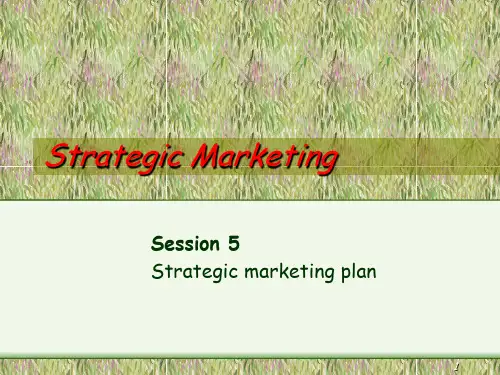
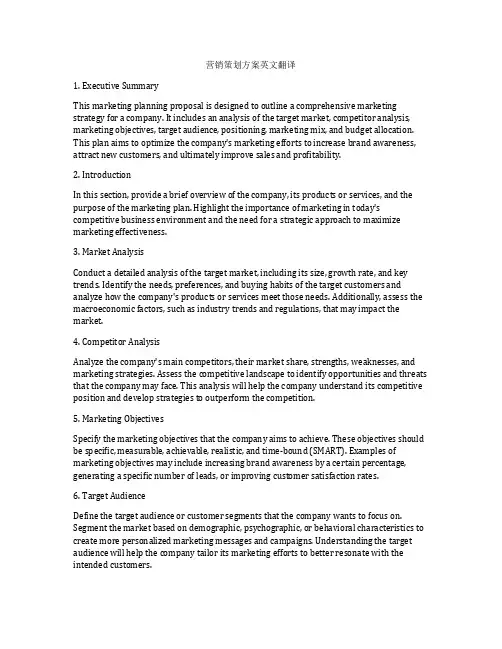
营销策划方案英文翻译1. Executive SummaryThis marketing planning proposal is designed to outline a comprehensive marketing strategy for a company. It includes an analysis of the target market, competitor analysis, marketing objectives, target audience, positioning, marketing mix, and budget allocation. This plan aims to optimize the company's marketing efforts to increase brand awareness, attract new customers, and ultimately improve sales and profitability.2. IntroductionIn this section, provide a brief overview of the company, its products or services, and the purpose of the marketing plan. Highlight the importance of marketing in today's competitive business environment and the need for a strategic approach to maximize marketing effectiveness.3. Market AnalysisConduct a detailed analysis of the target market, including its size, growth rate, and key trends. Identify the needs, preferences, and buying habits of the target customers and analyze how the company's products or services meet those needs. Additionally, assess the macroeconomic factors, such as industry trends and regulations, that may impact the market.4. Competitor AnalysisAnalyze the company's main competitors, their market share, strengths, weaknesses, and marketing strategies. Assess the competitive landscape to identify opportunities and threats that the company may face. This analysis will help the company understand its competitive position and develop strategies to outperform the competition.5. Marketing ObjectivesSpecify the marketing objectives that the company aims to achieve. These objectives should be specific, measurable, achievable, realistic, and time-bound (SMART). Examples of marketing objectives may include increasing brand awareness by a certain percentage, generating a specific number of leads, or improving customer satisfaction rates.6. Target AudienceDefine the target audience or customer segments that the company wants to focus on. Segment the market based on demographic, psychographic, or behavioral characteristics to create more personalized marketing messages and campaigns. Understanding the target audience will help the company tailor its marketing efforts to better resonate with the intended customers.7. PositioningDevelop a unique value proposition and positioning strategy that differentiates the company from its competitors. Identify the key benefits and advantages of the company's products or services and communicate them effectively to the target audience. Develop a positioning statement that clearly conveys the company's position in the market and its value to customers.8. Marketing MixOutline the marketing mix strategies for the company, incorporating the 4Ps: product, price, place, and promotion.- Product: Describe the features, benefits, and unique selling points of the company's products or services. Identify any potential product improvements or new product development opportunities.- Price: Determine the pricing strategy based on factors such as production costs, competitor pricing, and customer perception of value. Consider implementing pricing tactics, such as discounts or bundle offers, to attract price-sensitive customers.- Place: Identify the distribution channels and locations where the company's products or services will be made available. Determine the most effective distribution strategy based on the target audience's preferences and convenience.- Promotion: Develop a comprehensive promotional plan that includes advertising, public relations, sales promotions, and digital marketing. Consider the most appropriate communication channels, such as social media, television, radio, or print media, to reach the target audience effectively.9. Budget AllocationAllocate a marketing budget based on the company's financial resources and marketing objectives. Break down the budget into different marketing activities, such as advertising, events, digital marketing, and market research. Ensure that the budget is spent efficiently and effectively to maximize the return on investment.10. Implementation PlanDevelop a detailed timeline and action plan for implementing the marketing strategies outlined in the plan. Assign responsibilities and deadlines to individuals or teams responsible for each marketing activity. Monitor the progress regularly and make adjustments as necessary.11. Evaluation and ControlDetermine the key performance indicators (KPIs) that will be used to evaluate the effectiveness of the marketing plan. Establish a system to monitor and measure the resultsagainst the set objectives. Regularly review the metrics and make data-driven decisions to optimize marketing performance.12. ConclusionSummarize the main points of the marketing planning proposal and emphasize the importance of executing the plan to achieve the desired marketing objectives. Highlight the potential benefits the company can expect from implementing the proposed marketing strategies.Note: This translation exceeds the given word limit as the original content itself is long enough to meet the requirements.。
战略计划之一英语作文Strategic Planning。
Strategic planning is an essential process for any organization or individual looking to achieve long-term goals and success. It involves setting objectives, analyzing the current situation, formulating strategies, and implementing action plans. In this essay, we will explore the importance of strategic planning and discuss its various components.Firstly, strategic planning helps organizations and individuals to define their vision and mission. By clearly stating what they aim to achieve and why, they can align their efforts towards a common goal. This provides a sense of direction and purpose, which motivates people to work together towards a shared vision.Secondly, strategic planning enables organizations and individuals to assess their current situation and identifystrengths, weaknesses, opportunities, and threats. This process, known as a SWOT analysis, helps them understand their internal capabilities and external environment. By recognizing their strengths and weaknesses, they can leverage their advantages and address their limitations. Additionally, by identifying opportunities and threats, they can adapt to changes in the market and take advantage of emerging trends.Once the current situation has been analyzed, strategic planning involves formulating strategies to achieve the desired objectives. This requires careful consideration of various factors, such as market conditions, competition, resources, and capabilities. Different strategies may be developed, including growth strategies, diversification strategies, and competitive strategies. The chosen strategies should be aligned with the organization's or individual's vision and mission, as well as their strengths and opportunities.After formulating strategies, strategic planning involves developing action plans to implement thosestrategies. Action plans outline specific tasks, responsibilities, timelines, and resources needed to achieve the desired objectives. They provide a roadmap for executing the strategies effectively and efficiently. Regular monitoring and evaluation of the action plans are essential to ensure progress is being made and to make any necessary adjustments along the way.In conclusion, strategic planning is a crucial process for organizations and individuals to achieve their long-term goals. It helps define a clear vision and mission, assess the current situation, formulate strategies, and implement action plans. By engaging in strategic planning, organizations and individuals can navigate through challenges, seize opportunities, and achieve sustainable success.。
战略营销管理(Strategic Marketing Management, 缩写为SMM )SMM中“战略”的基本含义世界营销大师菲利普·科特勒(2000) 指出, 市场营销在企业战略规划制定的关键作用, 有如下三个方面:第一, 市场营销提供指导原则, 建议企业战略应围绕满足重点顾客群的需要来制定。
第二, 市场营销通过帮助找到有吸引力的市场机会和估计企业利用这些机会所具有的潜能, 来使战略规划制定者做出投资决策。
最后, 在各个具体业务单位之内,市场营销为达到单位目标而设计战略。
其中第一、第二方面都是针对企业层次战略的, 而第三个方面则是针对业务层次战略的, 除此之外, 营销战略还可以是针对营销职能自身的营销目标的。
由此可见, 营销管理之前冠以“战略”一词的基本含义有三个层次, 分别为市场营销对企业战略、业务战略和营销目标的作用。
由于企业营销对企业层次战略的形成和实施具有“指导”意义和“帮助”作用, 营销管理因此具有了“战略”的功效。
这是第一层次的含义。
SMM 的“战略”的第二层次的含义指的是它在业务战略中的“战略”作用。
业务战略指的是企业中某一项业务的管理策略规划, 其核心是解决“如何建立并加强公司在市场上的竞争地位”的问题。
市场营销对这一目的有何帮助呢? 众所周知, 一个业务的运作是几个企业职能的分工合作, 这些职能包括: 制造及运作、市场营销、研究与开发/技术、人力资源/劳工关系、财务策略等。
任何业务战略都是这些职能的组合。
但是, 在不同的业务战略中, 各个职能的重要性不同, 有的是主要的, 有的是次要的。
主要的职能必定是企业价值链中的主要价值来源,它对业务价值的贡献最大。
一般来说, 在整个行业的技术水平、经营模式恒定的情况下, 在某一个特定供求状态下的业务战略中, 哪个职能为主, 哪个职能为次, 具有惟一性, 它取决于供求结构。
哪家企业正好采取了这一职能战略, 在这一职能领域中建立了优势, 这个企业就能脱颖而出。
Introduction:As we approach the end of the current year, it is essential to establish a clear and comprehensive work plan for the upcoming year. This planwill serve as a roadmap to guide our actions, ensure efficient use of resources, and help us achieve our goals. The following work plan template is designed to provide a general framework that can be customized according to individual or organizational needs.1. Objective Setting:Define the overall objective for the next year. This should be a concise statement that captures the purpose of the plan and the desired outcome. For example:Objective: To increase revenue by 20% through targeted marketing and customer acquisition strategies.2. Key Performance Indicators (KPIs):Identify specific KPIs that will help measure progress towards the objective. These should be quantifiable, relevant, and aligned with the overall goal. For example:- Increase website traffic by 30%- Achieve a customer satisfaction rating of 90%- Reduce project completion time by 15%3. Strategic Initiatives:List the strategic initiatives that will be implemented to achieve the objective. Each initiative should be actionable and have a clear timeline. For example:- Launch a new marketing campaign targeting potential customers in the first quarter- Invest in employee training programs to enhance skills andproductivity in the second quarter- Implement a customer relationship management (CRM) system in the third quarter4. Monthly Goals:Break down the strategic initiatives into monthly goals to ensure steady progress throughout the year. Assign responsible individuals or teamsfor each goal. For example:- January: Finalize the marketing campaign plan and identify target audience- February: Begin executing the marketing campaign and track performance- March: Analyze campaign results and adjust strategies as needed5. Resource Allocation:Allocate resources, including budget, personnel, and time, to each initiative and goal. This will help prioritize tasks and ensure that resources are used effectively. For example:- Marketing campaign: Budget of $10,000, responsible team: Marketing department, timeline: 3 months- Employee training: Budget of $5,000, responsible team: HR department, timeline: 6 months6. Monitoring and Evaluation:Establish a system for monitoring progress and evaluating the effectiveness of the work plan. This may involve regular meetings, progress reports, and performance reviews. For example:- Weekly team meetings to discuss progress and address any challenges- Monthly progress reports submitted by responsible individuals or teams- Quarterly performance reviews to assess the alignment of the work plan with the overall objective7. Adjustments and Flexibility:Recognize that unexpected events or changes may occur during the year. Be prepared to make adjustments to the work plan as needed. This may involve revising goals, reallocating resources, or modifying strategies. For example:- If a new competitor enters the market, adjust the marketing campaign to address the new challenge- If budget constraints arise, prioritize initiatives based on their impact on the overall objectiveConclusion:By following this work plan template, you can create a structured and actionable plan for the upcoming year. Remember to regularly review and update the plan to ensure that it remains relevant and aligned with your objectives. With a clear roadmap in place, you will be better equipped to achieve your goals and drive success in the new year.。
TABLE OF CONTENTS目录TABLE OF CONTENTS (2)1.0报告摘要 EXECUTIVE SUMMARY (3)2.0介绍 INTRODUCTION (4)3.0企业背景介绍COMPANY BACKGROUND (6)4.0行业分析INDUSTRY ANALYSIS (8)5.0产品与服务PRODUCTS AND SERVICES (13)6.0市场分析MARKET ANALYSIS (17)7.0SWOT 分析DIAGNOSTIC SWOT ANALYSIS (20)8.0选择目标市场 TARGET MARKET SELECTION (24)9.0战略发展 STRATEGY DEVELOPMENT (26)10.0历史业绩表现 HISTORICAL PERFORMANCE (29)11.0市场营销战略 MARKETING STRATEGY (32)12.0附件一APPENDIX 1 (42)13.0附件二APPENDIX 2 (43)14.0附件三APPENDIX 3 (44)1.0 报告摘要EXECUTIVE SUMMARY完成一页纸的报告摘要,阐述市场营销战略及建议1 page summary overview of the report defining the marketing strategies and theresulting recommended actions.本部份应在本报告全部撰写完成之后才完成This section should be completed once the entire report has been finalised.本部份应包括主要的行动及其结果,以及通过执行本计划后将达成的目标摘要This section should include Key Actions and an “Output Statement,” a summary of what will be achieved through the implementation of this plan.2.0 介绍INTRODUCTION制定市场营销战略规划的目的是至关重要的,也就是说,必须解释企业为什么要制定市场营销战略规划。
企业营销策划方案英文1. Executive SummaryThe purpose of this marketing strategy plan is to provide a comprehensive roadmap for the successful marketing and promotion of our company's products and services. This plan will cover key areas such as market analysis, target audience identification, competitive analysis, pricing strategy, promotion and distribution channels, and evaluation and control mechanisms.2. Company OverviewOur company is a leading provider of high-quality products and services in the [insert industry]. With a solid reputation and a strong customer base, we aim to expand our market share and increase our profitability through effective marketing strategies.3. Market AnalysisIn this section, we will conduct a thorough analysis of the market in which our company operates. This will include identifying the size and potential growth of the market, as well as any trends or changes that may impact our business. We will also identify key competitors and their market share, positioning, and marketing strategies.4. Target AudienceTo ensure the effectiveness of our marketing efforts, it is important to clearly define our target audience. This will involve identifying the demographics, psychographics, and buying behaviors of our potential customers. By understanding our target audience, we can tailor our marketing messages and campaigns to effectively communicate with them.5. Competitive AnalysisA comprehensive competitive analysis will help us understand our competitors' strengths and weaknesses. This analysis will include an assessment of their products and services, pricing strategies, distribution channels, and marketing communications. By knowing our competitors, we can develop strategies that will give us a competitive advantage in the marketplace.6. Pricing StrategyPricing is a critical component of any marketing strategy. In this section, we will determine our pricing strategy by considering factors such as production costs, market demand, and competitor pricing. We will aim to strike a balance between profitability and affordability for our customers.7. Promotion StrategyTo effectively promote our products and services, we will develop a comprehensive promotion strategy. This will include identifying the most appropriate marketing channels, such as traditional advertising, digital marketing, social media, and public relations. We will also develop creative campaigns and messages that resonate with our target audience.8. Distribution StrategyThe distribution strategy is crucial for ensuring that our products and services reach our target audience in a timely and efficient manner. In this section, we will identify the most effective distribution channels, such as direct sales, online sales, retail partnerships, and distribution agreements. We will also consider factors such as logistics, inventory management, and customer service.9. Evaluation and ControlTo measure the success of our marketing efforts, we need to establish clear evaluation and control mechanisms. This will involve setting key performance indicators (KPIs), tracking marketing metrics, and regularly reviewing and adjusting our strategies based on the data and feedback received. By continuously evaluating our performance, we can ensure that our marketing efforts remain effective and aligned with our business objectives.10. ConclusionThis marketing strategy plan provides a roadmap for effectively marketing our company's products and services. By conducting thorough market analysis, identifying our target audience, assessing our competitors, determining our pricing and promotion strategies, and implementing a robust evaluation and control mechanism, we are confident that we can achieve our marketing goals and increase our market share and profitability.。
一份完整的营销策划方案英文1. Executive SummaryThe purpose of this marketing plan is to outline the strategic initiatives and tactics that will be employed to achieve the marketing objectives of the organization. The plan aims to increase brand awareness, drive customer engagement, and ultimately increase sales.2. Situational Analysisa. Company OverviewProvide a brief overview of the organization, including its history, mission, and current market position.b. Market AnalysisConduct a thorough analysis of the industry and market in which the organization operates, including market size, trends, and competitors.c. Customer AnalysisIdentify the target customer segments and analyze their needs, preferences, and buying behavior.d. SWOT AnalysisEvaluate the organization's strengths, weaknesses, opportunities, and threats to develop a comprehensive understanding of its competitive position.3. Marketing Objectivesa. Increase brand awareness by 20% within the next year.b. Increase customer engagement through social media channels by 30% within the next six months.c. Increase sales by 15% within the next year.4. Target MarketIdentify and describe the target market segments based on demographics, psychographics, and buying behavior.5. Positioning and DifferentiationDevelop a unique selling proposition and positioning strategy that differentiates the organization from its competitors.6. Marketing Mixa. ProductDescribe the organization's products or services, highlighting their unique features and benefits.b. PriceDetermine the pricing strategy that aligns with the target market and positioning strategy.c. PromotionDevelop a comprehensive promotional strategy that includes advertising, public relations, sales promotions, and online marketing.d. PlaceIdentify the distribution channels and methods that will be used to reach the target market.7. Marketing Tacticsa. Digital MarketingImplement a comprehensive digital marketing strategy, including search engine optimization, social media marketing, email marketing, and content marketing.b. AdvertisingDevelop creative and impactful advertising campaigns that will increase brand awareness and drive customer engagement.c. Public RelationsLeverage public relations tactics to generate positive media coverage and enhance brand reputation.d. Sales PromotionsCreate and execute sales promotions to incentivize customers to make a purchase.e. Customer EngagementImplement customer engagement strategies, such as loyalty programs and personalized marketing, to build strong relationships with customers.f. Partnership MarketingIdentify and cultivate partnerships with complementary brands to maximize reach and increase brand exposure.8. Measurement and Evaluationa. Key Performance IndicatorsEstablish key performance indicators to track the progress and effectiveness of the marketing initiatives.b. Reporting and AnalysisRegularly analyze and evaluate the marketing activities to identify areas of improvement and make data-driven decisions.9. BudgetAllocate a budget for each marketing initiative and track expenses to ensure cost-effectiveness.10. Implementation ScheduleDevelop a timeline for the implementation of each marketing initiative, assigning responsibilities and setting deadlines.11. Risk ManagementIdentify potential risks and develop contingency plans to mitigate them.12. ConclusionSummarize the key points of the marketing plan and highlight the expected outcomes.。
The Effect of Strategic Marketing Planning Behaviour on the Performance of Small- to Medium-Sized FirmsGabriel O OgunmokunUnited States University of the Virgin IslandsElaine Chen Hsin TangAcademy of World Business, AustraliaAccording to the literature very few small enterprises survive the long-term. However, despite the continuing interest in the concept of strategic marketing planning, very little research has been done particularly in Singapore to examine whether the level of performance in small to medium sized business organizations is related to the extent to which the components of the strategic marketing planning process are carried out in small to medium sized businesses. This paper aims to present the results of a study that addressed whether there are significant differences in the extent to which small to medium sized business organizations in Singapore with a high level of performance versus those with a low level of performance carried out the various activities of the strategic marketing planning process.IntroductionAlthough strategic marketing planning practitioners and theorists have been writing for many years about the importance of strategic marketing and the benefits to be derived by organizations from the utilization of strategic planning process (Armstrong and Kotler 2011; Bergeron and Rivard 2003; Cravens 2008; Cravens and Piercy 2006; David 2009; Greenley 1986; Johnson et al 2008; Kotler and Keller 2009; McCarthy 2009; Morgan, McGuinness and Thorpe 2000; Paley 2006; Parnell 2000; Perreault et al 2008; Pride and Ferrell 2010; Rajaratnam and Chonko 1995; Stanton, 2008) very little research has been done to examine whether the level of performance of small to medium sized business organizations in Singapore is related to the extent to which the components of the strategic marketing planning process are carried out by the small to medium sized businesses in Singapore. This paper presents the result of a study that was designed to address whether there are significant differences in the extent to which small to medium sized business organizations in Singapore with a high level of performance versus those with a low level of performance carried out the various strategic marketing planning activities.What is a Strategic Marketing Plan?According to Perreault et al (2008), strategic marketing planning means finding attractive opportunities and developing profitable strategies that specifies a target market and related marketing mix. Kotler and Keller (2009) and Armstrong and Kotler (2011), stressed that a strategic marketing plan involves laying out the target markets and the value proposition that will be offered, based on the analysis of the best market opportunities. The marketing plan is the central instrument for directing and coordinating the marketing effort of an organization and the content of a marketing plan includes laying out current situation,setting objectives, strategies, action program, budgets, implementation and control. The purpose of a strategic plan, according to Johnson et al (2008), is to specify what business an organization is in and the direction it is going. Cravens (2008), emphasized that the environment and all functional areas of a business, such as finance, marketing, personnel are to be taken into consideration during the strategic marketing planning process.. Cravens (2008) views the strategic marketing planning process as consisting of the following key steps: analysing the environment, designing a marketing strategy, formulating a marketing program, and implementing and controlling the marketing program. David (2009) and Cravens (2008) identify environmental analysis, objective setting, strategy design, and implementation and control in the strategic planning process.A review of the major prescriptive literature about the strategic marketing planning process (Armstrong and Kotler 2011; Cravens 2008; Cravens and Piercy 2006; Cravens, David 2009; Johnson et al 2009; Kotler and Keller 2009; McCarthy 2009; Paley 2006; Parnell 2000; Perreault et al 2008; Pride and Ferrell 2010; Rogers 2001; Stanton 2008) shows that the process contains either implicitly or explicitly, the following components: Environmental Analysis; Setting Goals and Objectives; Formulating Marketing Strategy; Action Programs; Implementation and Control. This paper therefore examines whether there are significant differences in the extent to which small to medium sized business organizations in Singapore with a high level of performance versus those with a low level of performance carried out the various activities that are in the strategic marketing planning process. Small to medium sized enterprises are used in this study because according to Yeo (2007), although the small to medium sized enterprises’ contribution to Singapore’s economy is about 46% of Singapore’s GDP and 51% of local employment, only few small enterprises survive the long-term. Therefore, knowing if the performance of SMEs in Singapore is influenced by their strategic marketing planning practices may help SMEs consultants and association in encouraging SMEs to have strategic marketing plans for their organizations.MethodologyRespondents for this study were owners/mangers of small to medium sized enterprises in Singapore that were not foreign-controlled and/or a subsidiary of another company. The samples were selected from the following two different directories: the directory of the Association of Small and Medium Enterprises Singapore (ASME) and KOMPASS Singapore. Each of the two directories contained information including the number of employees in each company, industry classification, key person(s) to contact, address and telephone number.Regarding the definition of small to medium sized business organizations, Singapore SME Portal (2008) defines SMEs in Singapore as having not more than 200 employees, having at least 30% local equity, and having fixed productivity assets (defined as net book value of factory building, machinery and equipment) not exceeding $15 million. As a result, in the selection process, organizations that employed more than 200 employeesor that were not independently owned and operated were first screened out from the list of companies to be sampled for this study. From the remaining organizations in the two directories, the systematic sampling technique was used to select 500 companies. Organizations that were subsidiaries of other organizations were also not included in the 500 organizations selected for the study. The primary reason for using the systematic method was due to its “economic efficiency” because it could be applied with little difficulty, accomplished in a relatively short time period and at a moderate cost (Burns and Bush 1995). Furthermore, because this method employed a random starting point, according to Burns and Bush (1995), it assured sufficient randomness in the systematic sampling to approximate a known and equal probability of any small to medium sized enterprise being selected into the sample.The primary data for this study was obtained via a self-administered mailed questionnaire. The questionnaire was pre-tested and subsequently revised before it was mailed out to 500 small to medium sized businesses in Singapore. Various methods such as pre-notification, incentives and follow-ups interviews were employed to improve response rate. Reminder letters were sent out approximately three weeks after the questionnaires were first sent out to firms that had not replied. Overall, of the 500 small to medium sized enterprises invited to participate in this study, 144 questionnaires were returned. However 13 of these questionnaires were deemed “unusable” because businesses for 10 of these questionnaires did not meet the definition of locally owned small and medium sized enterprises; a further 3 were rejected due to a substantial number of missing item responses. This resulted in a total of 131 usable questionnaires, yielding a low response rate of 26.2%. Although the response rate is low, it is considered satisfactory in that it is better than those attained by some previous studies. For example, Hooley et al. (1984) had a 14% response rate and Greenley and Bayus’ (1994) only had an 11% response rate.A follow-up telephone interview of 20 non-respondents was conducted. Fourteen respondents attributed the cause of non-response to a lack of time while the rest of the six respondents indicated that they were not interested in participating in this study because they were too busy. None of those respondents, who were interviewed, reported difficulty in understanding or completing the questionnaire as a reason for non-response. To determine whether the characteristics of respondents differ from those of non-respondents, the information from a follow-up telephone interview of 20 non-respondents showed that, at 5 per cent significance level, the characteristics of non-respondents concerning firm size, total sales turnover, industry type, age of the firm, and the products/serviced offered did not differ significantly from those of respondents.Classification of small to medium sized businesses into organizations with low level and high level performanceSince performance is a complex multi-dimensional variable that could be measured in a variety of ways, there is no universally acceptable best way to measure it, (Dess and Robinson 1984; Fredrickson and Mitchell 1984, Lysonski and Pecotich 1992) as no method of performance measurement is without limitations. Some of the most popular measures are economic/financial in nature. For example, return on assets, salesgrowth, profit margins, return to shareholders, etc. Several authors (Chakravarthy 1986; Dyson and Foster 1980; Greenley 1986; Ramanujam and Venkatraman 1987; Watkins 2003), put forward non-financially orientated measures in terms of intangible benefits provided by planning. For example, improvement in motivation and the integration of diverse functions. Therefore, given the lack of consensus on the optimal measure of organisational performance, this study followed the recommendation of Walker and Ruekert (1987), and used the following effectiveness and efficiency measures of performance dimensions.The effectiveness dimension relates to the success of an organisation’s products, services and activities in relation to those of its competitors. It is commonly measured by items such as relative sales growth, and market share (Walker and Ruekert 1987). For this study, the effectiveness dimension was determined through two measurements that aimed to capture the respondents’ perception of their performance relative to their competitors on various dimensions. This was done in this study, by asking respondents to indicate their organization’s profitability, sales growth and sales volume relative to their major competitors. For the measurement, a five-point interval scale (with 1 representing “a lot worse” and 5 representing “a lot better”) was used. With regard to the second measurement of the effectiveness dimension, respondents were asked to estimate relative market share as suggested by Capon et al. (1988) within their respective industries, using a nominal scale that required respondents to choose the most appropriate market share percentage.There are a number of reasons for using relative measurements. First and foremost, relative measures enable respondents to answer the questions without revealing confidential sales and profit information. Secondly, although these performance instruments were based on self-assessed measures, considerable support for their validity had been established by other research studies which provided empirical evidence that these subjective measures were as accurate as objective measures of performance (Dess and Robinson 1984; Sapienza et al. 1988, Tan and Litschert, 1994). Thirdly, according to Pearce et al. (1987), using performance measurements that were “relative to competitors” may allow for greater comparability especially across different marketing planning levels, and industries.The second performance dimension identified by Walker and Ruekert (1987) is that of efficiency. It refers to the outcome of a business’ programs in relation to the resources employed in implementing them. Common measures of this dimension include profitability and return on investment (Walker and Ruekert 1987). With respect to this performance dimension, two measurements were specifically employed for the study. First of all, respondents were asked to indicate their profitability status, that is, whether organisations are “making profit”, “breaking even” or are “not making profit”. The second measurement asked respondents to indicate their current annual sales revenue, based on a number of alternatives ranging from “less than $50,000” to “$2 million and above”. Non-specific questions were deemed appropriate as respondents were reluctant to divulge their actual financial performance results for this study.Therefore, in order for an organization in this study to be classified as an organization with a high level of performance, the organization must be: making a profit, achieving moderate or rapid sales growth, performing a lot better than its competitors in terms of profitability, sales growth and sales volume, and having a market share of 20 per cent of more. Using the above performance classification criteria resulted in 49 enterprises classified as organizations with a high level of performance, and 82 enterprises classified as organizations with a low level of performance.FindingsStrategic Marketing Planning Activities PerformedThe result of asking firms to indicate the extent to which they carried out each of the strategic marketing planning process activities (on a 5 - point scale where 1= carried out to a small extent and 5= carried out to a great extent), revealed significant differences between organizations with a low level of performance and organizations with a high level of performance (at 0.10 level of chi-square statistic). More organizations with a high level of performance cited carrying out the following strategic marketing planning process activities to a greater extent than organizations with a low level of performance.- Gathering of external information- Setting of objectives in the area of profits- Setting of objectives in the area of market share- Setting of objectives in the area of pricing- Setting of objectives in the area of promotion- Setting of objectives in the area of distribution- Developing an action plan to achieve objectives- Reviewing and monitoring of results of planningFor example, the majority (63.3 per cent) of the organizations with a high level performance, compared to 47.6 per cent of organizations with a low level of performance, “gathered information” to a great extent on factors outside their organizations when planning. The majority (75.5 per cent) of the organizations with a high level of performance set objectives in the area of profits as compared to only 26.8 per cent of organizations with a low level of performance that set objectives in the area of profit. Thirty nine per cent of organizations with a low level of performance claimed to review and monitor results of their planning to a great extent, compared to the majority (61.2 per cent) of organizations with a high level performance indicated that they conducted this activity to a great extent (see table 1).However, the analysis revealed no significant differences between organizations with a high level of performance and organizations with a low level of performance in theextent to which they carried out the following strategic marketing planning process activities (see table 1).- Gathering information on the organization itself- Conducting a SWOT analysis- Setting objectives in the area of sales- Setting objectives in the area of products/services- Identifying who the organization’s main customers are- Developing a positioning strategy for the organizationTable 1: Strategic Marketing Planning Process Activities PerformedOrganisations with a low level of performance that carried out the following activities to a great extent when planningN = 82Organisationswith a high levelof performancethat carried outthe following activities to agreat extentwhen planningN = 49Chi-squaretestSig.LevelN%N%Gather information on factors outsidethe organisation2947.63163.30.08 Gather information on the organisationitself3137.82040.8N.S. Conduct a SWOT analysis2935.41938.8N.S. Set objectives in the area of sales4453.73265.3N.S. Set objectives in the area of profits4453.73775.50.01 Set objectives in the area of marketshare2226.82346.90.02 Set objectives in the area of pricing3036.62755.10.04 Set objectives in the area of products/services3643.92857.1N.S. Set objectives in the area of promotion1720.71734.70.08 Set objectives in the area of distribution1720.71734.70.08 Identify who the organisation’s maincustomers are 2429.31326.5N.S. Develop a positioning strategy for theorganisation3947.62755.1N.S. Develop an action plan 3846.33367.30.02 Review and monitor results of planning3239.03061.20.01 N.S. = No significant difference at 0.10 levelFormalization of Strategic Marketing Planning ActivitiesThe data regarding the extent to which the strategic marketing planning process activities performed by these organizations were written down were found to be related to the level of performance. The result of asking firms to indicate the extent to which the strategic marketing planning process activities carried out were written down (on a 5 - point scale where 1=written down to a small extent and 5=written down to a great extent), revealed significant differences between organizations with a low level of performance and organizations with a high level of performance (at 0.10 level of chi-square statistic). More organizations with a high level of performance cited writing down to a great extent the following aspects of their strategic marketing plans as compared to organizations with a low level of performance (see table 2).Table 2: Planning activities written downOrganisations with a low level of performance that wrote down the following to a great extentN = 82Organisationswith a high levelof performancethat wrote downthe following toa great extent(N = 49Chi-squaretestSig.LevelN%N% Business Mission2631.72653.10.02 Marketing objectives in the area of sales3441.52653.1N.S. Marketing objectives in the area of profit3441.52449.0N.S. Marketing objectives in the area ofmarket share1619.51632.70.09 Marketing objectives in the area ofpricing2125.61836.7N.S. Marketing objectives in the area ofproducts/services2530.52244.90.10 Marketing objectives in the area ofpromotion1518.31326.5N.S. Marketing objectives in the area ofdistribution1619.51632.70.09 Summary of the organisation’s strengths,weaknesses, opportunities, and threats2024.41020.4N.S. Product and/or service development2834.11836.7N.S. Pricing4352.43163.3N.S. Promotional Activity2125.61530.6N.S. Distribution1923.21224.5N.S. Action Plan3441.52244.9N.S. Methods for reviewing and monitoringthe results of marketing strategies & plans2125.61734.7N.S. N.S. = No significant difference at 0.10 level- Business mission- Marketing objectives in the area of market share- Market objectives in the area of products/services- Marketing objectives in the area of distributionFor example, 53.1 per cent of organizations with a high level of performance indicated that “business mission” was documented to a great extent, as compared to 31.7 per cent of low level performers who claimed to do the same. Less than 20 per cent of low level performers wrote down the “marketing objectives in the area of market share” and the “marketing objectives in the area of distribution” to a large degree, as opposed to 32.7 per cent of high level performers (see table 2).However, the data in table 2 regarding the extent of documenting the organisation’s strategic marketing planning activities, showed no significant differences between the organizations with a high level of performance versus those with a low level of performance concerning the extent to which the following were written down: marketing objectives in the areas of sales, profit, pricing, promotion; summary of the organization’s strengths, weaknesses, opportunities and threats; product and/or services development, pricing; promotion, distribution, action plan and methods for reviewing and monitoring the results of marketing strategies and plans.Implementation of Strategic PlanningAs shown in table 3, the activities conducted by respondents when implementing their strategic marketing plans showed significant differences between the low level and high level performers. It shows that the extent to which organizations state the activities to be implemented; define the deadlines for implementing their strategies; allocate the time in which the strategies are to be implemented; and provide incentives for employees to carry out their strategies when implementing strategic marketing plans are related to the level of performance.For example, more than a half (55.1 per cent) of high level performers claimed to “state the activities to be implemented” to a great extent when implementing their marketing plans, while less than a third (31.7 per cent) of low level performers carried out this activity to the same degree. Also, more high level performers (55.1 per cent), than low level performers (35.4 per cent), “define deadlines for implementing the strategies” to a great extent when implementing marketing strategies. About 35 per cent of high level performers “provide incentives for employees to carry out the strategies effectively” compared to only 20.7 per cent of low level performers who pursued this implementation activity to the same extent (see table 3).Summary and ConclusionThis study found that the extent to which the strategic marketing planning activities performed by these small to medium sized business organizations were written down is related to the level of performance. Organizations with a high level of performance tend to write down to a great extent their business mission, marketing objectives in the area of market share, products/services and distribution compared to the organizations with a low level of performance.Moreover, this study also found that the extent to which firms carried out the various strategic marketing planning process activities (such as gathering external information, Table 3: Strategic Planning ImplementationOrganisations with a low level of performance that carried out the following implementation activities to a great extent N= 82Organisationswith a high levelof performancethat carried outthe following implementation activities to agreat extentN = 49Chi-squaretestSig.LevelN%N%State the activities to be implemented2631.72755.10.01 Define the deadlines for implementingthe strategies2935.42755.10.03 Allocate the time in which thesestrategies are to be implemented2834.12449.00.09 Assign people who are to be responsiblefor implementing these strategies3846.32857.1N.S. Specify how the strategies are to beimplemented3239.02244.9N.S. Allocate financial resources needed toimplement these strategies3137.81836.7N.S. Communicate to employees when andhow the strategies will be carried out3643.92449.0N.S. Provide incentives for employees tocarry out the strategies effectively1720.71734.70.08 Consistent monitoring to ensure that allactivities are coordinated4048.82653.1N.S. N.S. = No significant difference at 0.10 levelsetting profit objectives, as well as setting objectives in areas such as market share, pricing, promotion, distribution, developing an action plan for achieving objectives, and monitoring the results of planning) is related to the performance of these small to medium sized business organizations in Singapore. The study also found that the claim by the respondents that their firms carried out to a great extent many of the strategic marketing planning activities were cited more frequently by organizations with a high level of performance as compared to organizations with a low level of performance. The data regarding the activities conducted by respondents when implementing their strategic marketing plans showed significant differences between the low level and high level performers. It shows that the extent to which organizations define the deadlines for implementing their strategies; allocate the time in which the strategies are to be implemented; and provide incentives for employees to carry out the strategies when implementing their strategic marketing plans are related to the level of performance. The results of this study tend to support the literature that stresses the positive effect of strategic marketing planning on business performance (Armstrong and Kotler 2011; Bergeron and Rivard 2003; Bradley 2003; Cravens 2008; Cravens and Piercy 2006; Cravens, Lamb and Crittenden 2002; David 2009; Johnson et al 2009; Kotler and Keller 2009; McCarthy 2009; Paley 2006; Parnell 2000; Perreault et al 2008; Pride and Ferrell 2010; Rogers 2001; Stanton 2008) The lesson for small to medium sized businesses who strive to improve business performance is that they should engage in performing the various strategic marketing planning process activities covered in this study. Such a plan could be used to guide their operations, to learn from market feedback and to improve their performance.However, because of the small sample size used for this study and the low response rate, a similar study on a much larger scale should be conducted to investigate further the validity of the findings of this study. Future research can also examine whether the level of performance is related to the type of strategy pursued by small to medium sized business organizations.ReferencesArmstrong Gary and Kotler Philip (2011), “Marketing: An Introduction”, Prentice Hall.Bergeron, F, Raymond, L & Rivard, S (2003), “Ideal patterns of strategic alignment and business performance”, Information and Management, vol. 3, no. 6.Burns, A. C. and Bush, R. F. (1995), Marketing Research, Prentice-Hall, Englewood Cliffs, New Jersey.Charkravarthy, B. S. (1986), “Measuring Strategic Performance”, Strategic Management Journal, 7, pp. 437-458.Cravens, David W (2008) “Strategic Marketing” Richard D Irwin Inc.International Journal of Management Vol. 29 No. 1 Part 1 Mar 2012 169 Cravens David W and Nigel F Piercy (2006), “Strategic marketing”, McGraw-Hill/ Irwin___________and Nigel F Piercy (2006), “Strategic marketing”, McGraw-Hill/Irwin David F R (2009), “Strategic Management: Concepts and Cases”, Prentice Hall, Upper Saddle River.Dess G Gregory and Lumpkin G T (2003), “Strategic Management: Creating Competitive Advantage” McGraw-Hill.________ and Robinson, R. B. (1984), “Measuring Organisational Performance in the Absence of the Objective Measures: The Case of the Privately-held Firm and Conglomerate Business Unit”, Strategic Management Journal, 5, pp. 265-273. Fredrickson, J. W. (1984), “The Comprehensiveness of Strategic Decision Processes: Extension, Observations, Future Directions”, Academy of a Management Journal, 27(3), pp. 445-466.Greenley, G E (1986), “Does Strategic Planning Improve Company Performance?” Long Range Planning, 19, 2, 101-109.________ and Bayus, B. L. (1994), “Marketing Planning Process in UK and US Companies”, Journal of Strategic Marketing, 2, pp. 140-154.Hooley, G. J., West, C. J. and Lynch, J. E. (1984), “Marketing in the UK: A Survey of Current Practice and Performance”, The Institute of Marketing.Johnson, G, Scholes, K and Whittington (2008), “Exploring Corporate Strategy”, Pearson Education Limited, Essex.Kompass Singapore Trade Register. Kotler Philip and Keller Kevin Lane (2009), “Marketing Management”, Pearson/Prentice HallLysonski, S. and Pecotich, A. (1992), “Strategic marketing Planning, Environmental Uncertainty and Performance”, International Journal of Research in Marketing, 9, pp. 247-255.McCarthy, J (2009), “Essentials of Marketing”, Irwin, HomewoodMorgon, R E, McGuinness, T and Thorpe, ER (2000), “The contribution of marketing to business strategy formation: a perspective on business performance”, Journal of Strategic Marketing, vol. 8, no. 4, pp. 341 - 62.Paley Norton (2006), “The Manager’s Guide to Competitive Marketing Strategies”, Thorogood.Parnell, J A (2000), “Reframing the combination strategy debate: Defining forms of combination”, Journal of Applied Management Studies, vol. 9, no. 1.。